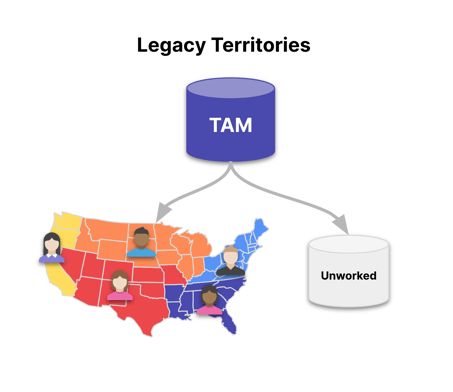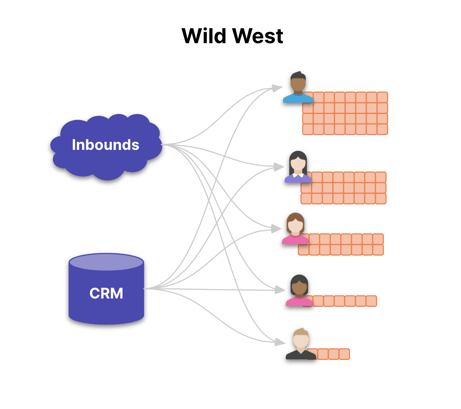Since starting Gradient Works, we've talked to hundreds of sales and RevOps leaders about how they deploy reps into the market. We're heard about amazing wins and big losses.
One thing stood out above the rest - static, geographic territories are holding teams back. They cause uneven attainment, making it hard to add reps and creating gaps in TAM coverage. So let's talk a little about exactly why static sales territories are problematic.
The trouble with territories
Only 53% of sales reps regularly hit quota. And despite significant investments in coaching, training and tools, attainment still suffers. Annual sales territory planning takes way too much time, and never produces the results you want.
76% of companies still use a geographic sales territory model to assign accounts to sales reps. And 83% of companies design their territories with spreadsheets. But opportunity is not distributed geographically.
With a traditional approach to sales territories, some reps get territories with so many high-potential accounts they can’t talk to them all, while other reps starve in territories with low potential. That results in:
- Attainment imbalances: Not every rep gets the same chance for success.
- Change challenges: Keeping territories balanced as teams change is complex.
- Missed opportunities: Inadequate TAM coverage costs you deals.
- Painful planning: Endless spreadsheets and meetings cost precious time
According to Forrester, “When sales territories are out of balance, organizations spend too much money and time on low-potential customers, while spending too little on high-potential customers. As a result, sales organizations can leave millions of dollars in lost productivity unrealized.”
What are the most common sales territory models?
Static sales territory model, aka the legacy model
First, the most common traditional sales territory model is a set of static territories, which has been the preferred form of territory design since the early 1900s. The idea is that you carve up your TAM into equal, fair, and cost-effective segments to distribute to your sales reps.
What do we mean when we say “static” territories?
We use the term “static” to describe any territory design that allocates a predefined group of accounts to a rep that they’re responsible for over a long period of time (usually a year). These territories are defined by one or more factors like company location, company size, potential revenue, and so on. Most companies still start from a geographic segmentation model even today.
Most sales teams with static territories carve up their addressable market during an annual territory planning process (which is probably starting around now for many of you. Having fun yet?). They then assign a sales rep to each pre-defined territory.
Static territories do not have to be geographic. Companies may give reps a group of named accounts that they’re responsible for. These accounts may have no particular geographic arrangement. We would still consider this a static sales territory because the set of accounts doesn’t change over time.

Static territories have some benefits, of course. They’re relatively simple to manage - you only need to do your analysis and planning once a year, and the reps can figure the rest out. They’re also familiar - most sales teams know what to expect from a static territory.
But static territories also have a number of significant disadvantages.
- Feast or famine: Prospects go unworked because some reps have too much opportunity while some other reps fight for scraps in weaker territories
- Prioritization problems: Annual carving process tries to balance potential but forces reps to decide who to engage and when on a daily basis
- Headcount headaches: Adding or losing reps is complex and disruptive due to “re-carving” or managing empty territories; meanwhile reps complain about accounts
- Capped coverage: Cumulative impact of these problems means quota capacity is misallocated and reps can’t effectively cover the TAM
Open territory model, aka the wild west approach
Another common territory model is what we call the wild west. You might even consider it an explicitly anti-territory model, where it’s every rep for themselves. In this model, a company defines its ICP and TAM, and reps are free to hunt for prospects anywhere, as long as they seem like they could be a good fit. It seems like the wild west, because it often is. Reps shoot first, and ask questions later.

The wild west model works fine for smaller or newer companies, who don’t need to implement a heavier territory model yet. But the wild west model has myriad disadvantages for most companies.
- Hoarding horrors: Reps who have been at the company the longest have accumulated lots of accounts, giving them an option on lots of inbounds
- Gaming attainment: Reps that have learned the right tricks are better at prospecting accounts in the CRM, rewarding insider knowledge, not sales skill
- Rough ramping: New reps struggle to ramp quickly because they start with a small book and have to pick through the dregs
- Unworked accounts: Reps have more accounts in their name than they can effectively work so your team isn’t fully covering your TAM
Why these territory design models don't work
Regardless of the model, traditional notions of static territories fail to account for the complexity of the modern sales cycle and leave a lot of unrealized revenue on the table.
Territories are inflexible and unfair, and no matter how much time a team spends on annual territory planning (and it will take months!), they're never perfect. In fact, they’re rarely even very good.
That’s because opportunity is not distributed statically. It's constantly changing, and geography has very little to do with it.
Territory design is incredibly difficult and time-consuming. It really does take most companies a few months every year to do the required analysis and political horse-trading involved in annual territory planning. That is such a huge time commitment, particularly when the final results don’t reflect the effort put into them.
And ongoing territory management is just as challenging - how do you keep territories balanced as accounts and reps move in and out? How do you deal with rep complaints and rules of engagement conflict? How do you ensure you’re covering your TAM? The reality is, you won't ever get this exactly right. And ultimately, attainment suffers.
A sales manager’s job is to ensure that every rep always has the right quota coverage to maximize attainment for the business. You can't do that with static territories. 100 years ago, this was the best sales teams could do. But we can do better now.
The future of territories isn't static
Many companies have recognized a traditional sales territory approach doesn't work and have taken baby steps away from annual geographic segments to a more agile approach for their reps. But so many more aren't sure where to start to move on to something more dynamic. That’s where dynamic book management comes in.
Dynamic book management is a new approach to territory design, built on best practices from top B2B inside sales teams. It’s a true alternative to traditional territory design that increases rep productivity and attainment by continually matching available rep capacity with the best available accounts.
For more on this topic, download our free guide to dynamic book management, and learn how a more flexible territory approach could work for your team. It will save you weeks of work this fall in territory planning, give your teams more predictability in their outreach, and increase attainment.





